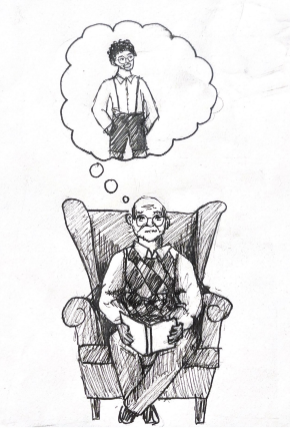
Amelia Shaw
I sit on the floor and cut out pictures from yellowed postcards I collected in Amsterdam. Carefully, I apply Elmers’s glue to the back of the images, calculating just the right amount to avoid unintentionally binding the pages together. Cut, glue, paste, repeat. The antiquated pictures of the Rijksmuseum and the Rembrandt house stand out like a stain on the fresh white sheets of my green Moleskine notebook. I wave the book through the air in an attempt to get the glue to dry faster.
Once I am sure the pages are dry, I begin to write. I conjure memories, haphazardly recounting the feelings that permeated my psyche while eating mini pancakes by the canal. The cinnamon and powdered sugar fall from the warm bread as the Dutch hurry past on their bicycles. The richness of my mom’s laugh as a pigeon begs for one of the pancakes. Sounds, smells and tastes distilled into sentences, simplified for remembrance. The complexity of my day boiled down to the letters of the alphabet scribbled in my hastened handwriting. Sometimes, this means elaborate scrawling paragraphs with ornate adjectives; other times, it means a single sentence — “Today, I went to the beach, and I was happy.”
I rapidly press the button on my camera app to capture a moment. But the notebooks are more methodical. The notebook pages become the canon of my life. These written pictures interact with all the senses of my body, allowing for a more cogent recollection than any iPhone image could ever provide.
I try to capture myself daily, a feeble attempt to immortalize the creature I am now. I don’t only do this when I am on exciting trips, but in the fleeting moments of my life that create my days, capturing life between the exciting. The sunlight that poured through the third-floor window of Phelps Hall while we translated a heartbreaking epitaph. The excitement that radiated from my mother while she talked about our duck hatching her ducklings. The guilt I felt after eating a pint of ice cream at midnight.
I claim these seemingly mundane moments as “proof of life.” I frequently look back to relive them: the day I toured Yale October of 2022, the day my first dog died and many times when I felt like the world was collapsing around me. I don’t always like to relive parts of myself — i.e., my sixth-grade homecoming dance, crying in my Algebra 2 class in front of everyone and that hateful remark I made to my grandma. However, cowering at the way I was isn’t always a bad thing; those are just the growing pains. That is just the cost of immortalizing yourself.
When a notebook is halfway full — a sign of my commitment — I will put a label on the cover. The label reminds the reader of the versions of myself they will find breathing life into the pages. The most recent one possesses the words Poetic endeavors, Europe 2024, Summer and Freshman Fall at Yale.
One day, I’ll be able to open the notebook and read the pages aloud. My notebook becomes a map: X marks the spot where the boy buried beneath the slates of my ribs lays. A graveyard of every person I have ever been, lying just beneath my consciousness, waiting to be remembered. In reading the pages, I dig myself up. A quote I loved from Didion, the anger filling my face while someone chewed in my ear at lunch, the time I laughed until I was gasping for air scribbled down acting as evocations for past lives.
These evocations never fail to guide me back to my heart on the day I wish to remember. After reading, I close my eyes and let the words carry me to the moments: the excited thudding in my chest on my first date, the overwhelming exhaustion after the Boygenius concert while driving home at 1 a.m. and the halting of my heartbeat when waiting to see who was getting sent home on “Survivor.”
Every version of me lives to transcend time. Time may weather my body, and the pages of the Moleskine notebook bought in a dingy Barnes and Noble in Texas may yellow, but the words live. Deathless in my art.
I am alive; I am alive in the pages of my notebooks.







